Advances in Emerging Non-Destructive Technologies for Detecting Raw Egg Freshness: A Comprehensive Review
Abstract
1. Introduction
2. Nutritional Compositions of Egg
2.1. Macronutrients
2.2. Micronutrients
2.3. Bioactive Compounds
3. Detection Methods of Egg Freshness
3.1. Traditional Assessment Methods
3.1.1. Sensory Evaluation
3.1.2. Physicochemical Analysis

3.2. Non-Destructive Methods
3.2.1. Near-Infrared (NIR) Spectroscopy
3.2.2. Raman Spectroscopy
3.2.3. Dielectric Spectroscopy
3.2.4. Fluorescence Spectroscopy
3.2.5. Computer Vision/Traditional Color Imaging
3.2.6. Hyperspectral Imaging
3.2.7. Electronic Noses and Tongues
3.2.8. Low-Field Nuclear Magnetic Resonance
4. Challenges and Future Trends
5. Conclusions and Future Directions
Author Contributions
Funding
Institutional Review Board Statement
Informed Consent Statement
Data Availability Statement
Acknowledgments
Conflicts of Interest
References
- Vandeginste, V. Food waste eggshell valorization through development of new composites: A review. Sustain. Mater. Technol. 2021, 29, e00317. [Google Scholar] [CrossRef]
- Agregán, R.; Munekata, P.E.; Putnik, P.; Pateiro, M.; Bursać Kovačević, D.; Zavadlav, S.; Lorenzo, J.M. The Use of Novel Technologies in Egg Processing. Food Rev. Int. 2023, 39, 2854–2874. [Google Scholar] [CrossRef]
- Anton, M.; Lechevalier, V.; Nau, F. From Eggs to Egg Products. In Handbook of Food Science and Technology 3; John Wiley & Sons: Hoboken, NJ, USA, 2016; pp. 115–143. [Google Scholar]
- Sharif, M.K.; Saleem, M.; Javed, K. Chapter 15—Food Materials Science in Egg Powder Industry. In Role of Materials Science in Food Bioengineering; Grumezescu, A.M., Holban, A.M., Eds.; Academic Press: Cambridge, MA, USA, 2018; pp. 505–537. [Google Scholar]
- Chambers, J.R.; Zaheer, K.; Akhtar, H.; Abdel-Aal, E.-S.M. Chapter 1—Chicken Eggs. In Egg Innovations and Strategies for Improvements; Hester, P.Y., Ed.; Academic Press: San Diego, CA, USA, 2017; pp. 1–9. [Google Scholar]
- Guyot, N.; Nys, Y. Egg quality and preservation in the domestic fowl: Eggs as human food. Poult. Sci. 2017, 96, 1440–1453. [Google Scholar]
- Robinson, D.S. Food biochemistry and food processing. In Food Biochemistry and Food Processing; Wiley-Blackwell: Hoboken, NJ, USA, 2001; pp. 217–243. [Google Scholar]
- Vlčková, J.; Tůmová, E.; Míková, K.; Englmaierová, M.; Okrouhlá, M.; Chodová, D. Changes in the quality of eggs during storage depending on the housing system and the age of hens. Poult. Sci. 2019, 98, 6187–6193. [Google Scholar] [CrossRef]
- Li-Chan, E.C.; Powrie, W.D.; Nakai, S. The chemistry of eggs and egg products. In Egg Science and Technology; Pearson, A.M., Dutson, T.R., Eds.; AVI Publishing: Baton Rouge, LA, USA, 1986; pp. 97–139. [Google Scholar]
- Qi, L.; Zhao, M.C.; Li, Z.; Shen, D.H.; Lu, J. Non-destructive testing technology for raw eggs freshness: A review. SN Appl. Sci. 2020, 2, 1113. [Google Scholar] [CrossRef]
- Yao, K.; Sun, J.; Zhang, B.; Du, X.; Chen, C. On-line monitoring of egg freshness using a portable NIR spectrometer combined with deep learning algorithm. Infrared Phys. Technol. 2024, 138, 105207. [Google Scholar] [CrossRef]
- Berkhoff, J.; Alvarado-Gilis, C.; Keim, J.P.; Alcalde, J.A.; Vargas-Bello-Pérez, E.; Gandarillas, M. Consumer preferences and sensory characteristics of eggs from family farms. Poult. Sci. 2020, 99, 6239–6246. [Google Scholar] [CrossRef]
- Nematinia, E.; Abdanan Mehdizadeh, S. Assessment of egg freshness by prediction of Haugh unit and albumen pH using an artificial neural network. J. Food Meas. Charact. 2018, 12, 1449–1459. [Google Scholar] [CrossRef]
- Dong, X.; Zhang, B.; Dong, J.; Lu, B.; Hu, C.; Tang, X. Egg freshness prediction using a comprehensive analysis based on visible near infrared spectroscopy. Spectrosc. Lett. 2020, 53, 512–522. [Google Scholar] [CrossRef]
- Jiang, Y.; Fu, D.; Ma, M. Egg Freshness Indexes Correlations with Ovomucin Concentration during Storage. J. Food Qual. 2022, 2022, 9562886. [Google Scholar] [CrossRef]
- Dong, X.; Dong, J.; Peng, Y.; Tang, X. Comparative study of albumen pH and whole egg pH for the evaluation of egg freshness. Spectrosc. Lett. 2017, 50, 463–469. [Google Scholar] [CrossRef]
- Zhang, J.; Lu, W.; Jian, X.; Hu, Q.; Dai, D. Nondestructive Detection of Egg Freshness Based on Infrared Thermal Imaging. Sensors 2023, 23, 5530. [Google Scholar] [CrossRef] [PubMed]
- Aboonajmi, M.; Mostafaei, Z. Non-destructive Quality Assessment of Table Eggs for Online Sorting. In Informatics in Poultry Production: A Technical Guidebook for Egg and Poultry Education, Research and Industry; Springer: Berlin/Heidelberg, Germany, 2022; pp. 35–51. [Google Scholar]
- Liu, Y.; Ren, X.; Yu, H.; Cheng, Y.; Guo, Y.; Yao, W.; Xie, Y. Non-destructive and online egg freshness assessment from the egg shell based on Raman spectroscopy. Food Control 2020, 118, 107426. [Google Scholar] [CrossRef]
- Ahmed, M.W.; Hossainy, S.J.; Khaliduzzaman, A.; Emmert, J.L.; Kamruzzaman, M. Non-destructive optical sensing technologies for advancing the egg industry toward Industry 4.0: A review. Compr. Rev. Food Sci. Food Saf. 2023, 22, 4378–4403. [Google Scholar] [CrossRef]
- de Oliveira-Boreli, F.P.; Pereira, D.F.; Gonçalves, J.A.; da Silva, V.Z.; Nääs, I.D.A. Non-destructive assessment of hens’ eggs quality using image analysis and machine learning. Smart Agric. Technol. 2023, 4, 100161. [Google Scholar] [CrossRef]
- Loffredi, E.; Grassi, S.; Alamprese, C. Spectroscopic approaches for non-destructive shell egg quality and freshness evaluation: Opportunities and challenges. Food Control 2021, 129, 108255. [Google Scholar] [CrossRef]
- Réhault-Godbert, S.; Guyot, N.; Nys, Y. The Golden Egg: Nutritional Value, Bioactivities, and Emerging Benefits for Human Health. Nutrients 2019, 11, 684. [Google Scholar] [CrossRef]
- Rafed, R.; Abedi, M.H.; Mushfiq, S.R. Nutritional Value of Eggs in Human Diet. J. Res. Appl. Sci. Biotechnol. 2024, 3, 172–176. [Google Scholar] [CrossRef]
- Seuss-Baum, I.; Nau, F. The nutritional quality of eggs. In Improving the Safety and Quality of Eggs and Egg Products; Elsevier: Amsterdam, The Netherlands, 2011; pp. 201–236. [Google Scholar]
- USDA. National Nutrient Database for Standard Reference, Release 1; U.S. Department of Agriculture. Food Group: Dairy and Egg Products: Beltsville, MD, USA, 2018. [Google Scholar]
- Medina-Cruz, M.F.; Zárate-Contreras, D.; Pérez-Ruiz, R.V.; Aguilar-Toalá, J.E.; Rosas-Espejel, M.; Cruz-Monterrosa, R.G. Nutritional aspects, production and viability in the market of organic chicken eggs: Review. Food Chem. Adv. 2024, 4, 100595. [Google Scholar] [CrossRef]
- Walker, S.; Baum, J. Eggs as an affordable source of nutrients for adults and children living in food-insecure environments. Nutr. Rev. 2022, 80, 178–186. [Google Scholar] [CrossRef]
- Lutter, C.; Iannotti, L.; Stewart, C. The potential of a simple egg to improve maternal and child nutrition. Matern. Child Nutr. 2018, 14, e12678. [Google Scholar] [CrossRef] [PubMed]
- Gallo, M.; Gámiz, F. Choline: An Essential Nutrient for Human Health. Nutrients 2023, 15, 2900. [Google Scholar] [CrossRef] [PubMed]
- Wallace, T.C. A Comprehensive Review of Eggs, Choline, and Lutein on Cognition Across the Life-span. J. Am. Coll. Nutr. 2018, 37, 269–285. [Google Scholar] [CrossRef] [PubMed]
- Nys, Y.; Sauveur, B. Valeur nutritionnelle des oeufs. INRAE Prod. Anim. 2004, 17, 385–393. [Google Scholar] [CrossRef]
- Silva, V.; Jayasinghe, M.A.; Senadheera, S.A.; Ranaweera, K.K.D.S. Determination of macronutrient compositions in selected, frequently consumed cereals, cereal based foods, legumes and pulses prepared according to common culinary methods in Sri Lanka. J. Food Sci. Technol. 2020, 57, 816–820. [Google Scholar] [CrossRef]
- Gautron, J.; Réhault-Godbert, S.; Nys, Y.; Mann, K.; Righetti, P. Use of high-throughput technology to identify new egg components. In Improving the Safety and Quality of Eggs and Egg Products; Elsevier: Amsterdam, The Netherlands, 2011; pp. 133–150. [Google Scholar]
- Chang, C.; Lahti, T.; Tanaka, T.; Nickerson, M.T. Egg proteins: Fractionation, bioactive peptides and allergenicity. J. Sci. Food Agric. 2018, 98, 5547–5558. [Google Scholar] [CrossRef]
- Anton, M. Egg yolk: Structures, functionalities and processes. J. Sci. Food Agric. 2013, 93, 2871–2880. [Google Scholar] [CrossRef]
- Mann, K. Proteomic analysis of the chicken egg vitelline membrane. Proteomics 2008, 8, 2322–2332. [Google Scholar] [CrossRef]
- Shinn, S.; Liyanage, R.; Lay, J., Jr.; Proctor, A. Isolation and characterization of chicken yolk vitelline membrane lipids using eggs enriched with conjugated linoleic acid. Lipids 2016, 51, 769–779. [Google Scholar] [CrossRef]
- Kim, J.; Campbell, W. Dietary cholesterol contained in whole eggs is not well absorbed and does not acutely affect plasma total cholesterol concentration in men and women: Results from 2 randomized controlled crossover studies. Nutrients 2018, 10, 1272. [Google Scholar] [CrossRef]
- Staggs, C.; Sealey, W.; McCabe, B.; Teague, A.; Mock, D. Determination of the biotin content of select foods using accurate and sensitive HPLC/avidin binding. J. Food Compos. Anal. 2004, 17, 767–776. [Google Scholar] [CrossRef] [PubMed]
- Barnkob, L.L.; Argyraki, A.; Jakobsen, J. Naturally enhanced eggs as a source of vitamin D: A review. Trends Food Sci. Technol. 2020, 102, 62–70. [Google Scholar] [CrossRef]
- Patterson, K.Y.; Bhagwat, S.A.; Williams, J.R.; Howe, J.C.; Holden, J.M.; Zeisel, S.H.; Dacosta, K.A.; Mar, M.H. USDA Database for the Choline Content of Common Foods, Release Two. 2008. Available online: http://www.ars.usda.gov/nutrientdata (accessed on 30 March 2024).
- Wiedeman, A.M.; Barr, S.I.; Green, T.J.; Xu, Z.; Innis, S.M.; Kitts, D.D. Dietary choline intake: Current state of knowledge across the life cycle. Nutrients 2018, 10, 1513. [Google Scholar] [CrossRef] [PubMed]
- Øyen, J.; Gjesdal, C.G.; Karlsson, T.; Svingen, G.F.; Tell, G.S.; Strand, E.; Drevon, C.A.; Vinknes, K.J.; Meyer, K.; Ueland, P.M.; et al. Dietary choline intake is directly associated with bone mineral density in the Hordaland Health Study. J. Nutr. 2017, 147, 572–578. [Google Scholar] [CrossRef] [PubMed]
- Wang, J.; Um, P.; Dickerman, B.A.; Liu, J. Zinc, magnesium, selenium and depression: A review of the evidence, potential mechanisms and implications. Nutrients 2018, 10, 584. [Google Scholar] [CrossRef] [PubMed]
- López-Martínez, M.I.; Moreno-Fernández, S.; Miguel, M. Development of functional ice cream with egg white hydrolysates. Int. J. Gastron. Food Sci. 2021, 25, 100334. [Google Scholar] [CrossRef]
- Miranda, J.M.; Anton, X.; Redondo-Valbuena, C.; Roca-Saavedra, P.; Rodriguez, J.A.; Lamas, A.; Franco, C.M.; Cepeda, A. Egg and egg-derived foods: Effects on human health and use as functional foods. Nutrients 2015, 7, 706–729. [Google Scholar] [CrossRef]
- USDA. National Nutrient Database for Standard Reference, Release 27 (Revised); May 2015 Version; US Department of Agriculture, Agricultural Research Service, Nutrient Data Laboratory: Beltsville, MD, USA, 2015. [Google Scholar]
- McClements, D.J. Future foods: Is it possible to design a healthier and more sustainable food supply? Nutr. Bull. 2020, 45, 341–354. [Google Scholar] [CrossRef]
- Kumari, A.; Tripathi, U.K.; Maurya, V.; Kumar, M. Internal quality changes in eggs during storage. Int. J. Sci. Environ. Technol. 2020, 9, 615–624. [Google Scholar]
- NHFBC. National Food Safety Standard-Egg and Egg Products; China Standards Press: Beijing, China, 2015. [Google Scholar]
- Karoui, R.; Kemps, B.; Bamelis, F.; De Ketelaere, B.; Decuypere, E.; De Baerdemaeker, J. Methods to evaluate egg freshness in research and industry: A review. Eur. Food Res. Technol. 2006, 222, 727–732. [Google Scholar] [CrossRef]
- Stadelman, W.J.; Cotterill, O.J. Egg Science and Technology, 4th ed.; CRC Press: New York, NY, USA, 2017. [Google Scholar]
- Nasri, H.; van den Brand, H.; Najjar, T.; Bouzouaia, M. Egg storage and breeder age impact on egg quality and embryo development. J. Anim. Physiol. Anim. Nutr. 2020, 104, 257–268. [Google Scholar] [CrossRef] [PubMed]
- Ayoola, M.O.; Olufemi, A.M.; Foluke, A.; Oguntunji, A. Relationship of temperature and length of storage on pH of internal contents of chicken table egg in humid tropics. Biotechnol. Anim. Husb. 2016, 32, 285–296. [Google Scholar] [CrossRef]
- Brodacki, A.; Batkowska, J.; Drabik, K.; Chabroszewska, P.; Łuczkiewicz, P. Selected quality traits of table eggs depending on storage time and temperature. Br. Food J. 2019, 121, 2016–2026. [Google Scholar] [CrossRef]
- Zhang, G.; Chen, A.; Zhao, Y.; Xu, Z.; Chen, G.; Yang, S. Egg Safety Standards in China Need To Be Improved. J. Food Prot. 2016, 79, 512–518. [Google Scholar] [CrossRef]
- Eisen, E.J.; Bohren, B.B.; McKean, H.E. The Haugh unit as a measure of egg albumen quality. Poult. Sci. 1962, 41, 1461–1468. [Google Scholar] [CrossRef]
- Narushin, V.G.; Romanov, M.N.; Griffin, D.K. A novel Egg Quality Index as an alternative to Haugh unit score. J. Food Eng. 2021, 289, 110176. [Google Scholar] [CrossRef]
- Jones, D. Haugh Unit: Gold Standard of Egg Quality. Natl. Egg Qual. Sch. Proc. 2012, 7, 47–51. Available online: https://www.ars.usda.gov/research/publications/publication/?seqNo115=280843 (accessed on 5 April 2024).
- Harnsoongnoen, S.; Jaroensuk, N. The grades and freshness assessment of eggs based on density detection using machine vision and weighing sensor. Sci. Rep. 2021, 11, 16640. [Google Scholar] [CrossRef]
- Chen, Q.; Saatkamp, H.W.; Cortenbach, J.; Jin, W. Comparison of Chinese Broiler Production Systems in Economic Performance and Animal Welfare. Animals 2020, 10, 491. [Google Scholar] [CrossRef]
- Wang, Y.; Liu, L.Z.; Gong, Z.; Fang, M. Study on application of chlorine dioxide treatment in disinfection and fresh-keeping of shell eggs. Food Sci. 2008, 29, 632–636. [Google Scholar] [CrossRef]
- Guo, H.; Bao, Z.; Zhang, S.; Ran, Y.; Ning, R.; Li, Y.; Zhang, J.; Li, J.; Liu, Q.; He, L. A Novel NIR-Based Strategy for Rapid Freshness Assessment of Preserved Eggs. Food Anal. Methods 2022, 15, 1457–1469. [Google Scholar] [CrossRef]
- Huang, Q.; Qiu, N.; Ma, M.H.; Jin, Y.G.; Yang, H.; Geng, F.; Sun, S.H. Estimation of egg freshness using S-ovalbumin as an indicator. Poult. Sci. 2012, 91, 739–743. [Google Scholar] [CrossRef] [PubMed]
- Eke, M.; Olaitan, N.; Ochefu, J. Effect of storage conditions on the quality attributes of shell (table) eggs. Niger. Food J. 2013, 31, 18–24. [Google Scholar] [CrossRef]
- Navara, K.J.; Graden, K.; Mendonça, M.T. Dietary yolk supplementation decreases rates of yolk deposition in Japanese quail. J. Exp. Zool. Part A Ecol. Integr. Physiol. 2023, 339, 63–73. [Google Scholar] [CrossRef]
- Hisasaga, C.; Griffin, S.E.; Tarrant, K.J. Survey of egg quality in commercially available table eggs. Poult. Sci. 2020, 99, 7202–7206. [Google Scholar] [CrossRef]
- Dong, X.; Li, Z.; Shen, Z.; Tang, X. Nondestructive egg freshness assessment from the equatorial and blunt region based on visible near infrared spectroscopy. Spectrosc. Lett. 2018, 51, 540–546. [Google Scholar] [CrossRef]
- Wang, F.; Lin, H.; Xu, P.; Bi, X.; Sun, L. Egg Freshness Evaluation Using Transmission and Reflection of NIR Spectroscopy Coupled Multivariate Analysis. Foods 2021, 10, 2176. [Google Scholar] [CrossRef]
- Fu, D.; Li, Q.; Chen, Y.; Ma, M.; Tang, W. Assessment of integrated freshness index of different varieties of eggs using the visible and near-infrared spectroscopy. Int. J. Food Prop. 2023, 26, 155–166. [Google Scholar] [CrossRef]
- Syduzzaman, M.; Khaliduzzaman, A.; Rahman, A.; Kashimori, A.; Suzuki, T.; Ogawa, Y.; Kondo, N. Non-invasive classification of single and double-yolk eggs using Vis-NIR spectroscopy and multivariate analysis. Br. Poult. Sci. 2023, 64, 1–9. [Google Scholar] [CrossRef]
- Cruz-Tirado, J.P.; Lucimar da Silva Medeiros, M.; Barbin, D.F. On-line monitoring of egg freshness using a portable NIR spectrometer in tandem with machine learning. J. Food Eng. 2021, 306, 110643. [Google Scholar] [CrossRef]
- Mehdizadeh, S.; Minaei, S.; Hancock, N.; Torshizi, M. An intelligent system for egg quality classification based on visible-infrared transmittance spectroscopy. Inf. Process. Agric. 2014, 1, 105–114. [Google Scholar] [CrossRef]
- Akbarzadeh, N.; Mireei, S.A.; Askari, G.; Mahdavi, A.H. Microwave spectroscopy based on the waveguide technique for the nondestructive freshness evaluation of egg. Food Chem. 2019, 277, 558–565. [Google Scholar] [CrossRef]
- Kemps, B.J.; Bamelis, F.R.; De Ketelaere, B.; Mertens, K.; Tona, K.; Decuypere, E.M.; De Baerdemaeker, J.G. Visible transmission spectroscopy for the assessment of egg freshness. J. Sci. Food Agric. 2006, 86, 1399–1406. [Google Scholar] [CrossRef]
- Joshi, R.; Lohumi, S.; Joshi, R.; Kim, M.S.; Qin, J.; Baek, I.; Cho, B.-K. Raman spectral analysis for non-invasive detection of external and internal parameters of fake eggs. Sens. Actuators B Chem. 2020, 303, 127243. [Google Scholar] [CrossRef]
- Davari, M.; Bahreini, M.; Sabzevari, Z. Developing a non-destructive method for the detection of egg quality and freshness using micro-Raman spectroscopy. Appl. Food Res. 2024, 4, 100453. [Google Scholar] [CrossRef]
- Soltani, M.; Omid, M.; Alimardani, R. Egg quality prediction using dielectric and visual properties based on artificial neural network. Food Anal. Methods 2015, 8, 710–717. [Google Scholar] [CrossRef]
- Ragni, L.; Cevoli, C.; Berardinelli, A. A waveguide technique for non-destructive determination of egg quality parameters. J. Food Eng. 2010, 100, 343–348. [Google Scholar] [CrossRef]
- Karoui, R.; Schoonheydt, R.; Decuypere, E.; Nicolaï, B.; De Baerdemaeker, J. Front face fluorescence spectroscopy as a tool for the assessment of egg freshness during storage at a temperature of 12.2 °C and 87% relative humidity. Anal. Chim. Acta 2007, 582, 83–91. [Google Scholar] [CrossRef]
- Karoui, R.; Nicolaï, B.; De Baerdemaeker, J. Monitoring the Egg Freshness During Storage Under Modified Atmosphere by Fluorescence Spectroscopy. Food Bioprocess Technol. 2008, 1, 346–356. [Google Scholar] [CrossRef]
- Asadi, V.; Raoufar, M.; Nassiri, S. Fresh egg mass estimation using machine vision technique. Int. Agrophys. 2012, 26, 229–234. [Google Scholar] [CrossRef]
- Sun, L.; Yuan, L.; Cai, J.; Lin, H.; Zhao, J. Egg freshness on-line estimation using machine vision and dynamic weighing. Food Anal. Methods 2015, 8, 922–928. [Google Scholar] [CrossRef]
- Guanjun, B.; Mimi, J.; Yi, X.; Shibo, C.; Qinghua, Y. Cracked egg recognition based on machine vision. Comput. Electron. Agric. 2019, 158, 159–166. [Google Scholar] [CrossRef]
- Priyadumkol, J.; Kittichaikarn, C.; Thainimit, S. Crack detection on unwashed eggs using image processing. J. Food Eng. 2017, 209, 76–82. [Google Scholar] [CrossRef]
- Suktanarak, S.; Teerachaichayut, S. Non-destructive quality assessment of hens’ eggs using hyperspectral images. J. Food Eng. 2017, 215, 97–103. [Google Scholar] [CrossRef]
- Dai, D.; Jiang, T.; Lu, W.; Shen, X.; Xiu, R.; Zhang, J. Nondestructive Detection for Egg Freshness Based on Hyperspectral Scattering Image Combined with Ensemble Learning. Sens. Actuators B Chem. 2020, 20, 5484. [Google Scholar] [CrossRef]
- Zhang, W.; Pan, L.; Tu, S.; Zhan, G.; Tu, K. Non-destructive internal quality assessment of eggs using a synthesis of hyperspectral imaging and multivariate analysis. J. Food Eng. 2015, 157, 41–48. [Google Scholar] [CrossRef]
- Dong, X.; Gao, L.; Zhang, H.; Wang, J.; Qiu, K.; Qi, G.; Wu, S. Comparison of Sensory Qualities in Eggs from Three Breeds Based on Electronic Sensory Evaluations. Foods 2021, 10, 1984. [Google Scholar] [CrossRef]
- Yimenu, S.M.; Kim, J.Y.; Kim, B.S. Prediction of egg freshness during storage using electronic nose. Poult. Sci. 2017, 96, 3733–3746. [Google Scholar] [CrossRef]
- Li, J.T.; Wang, J.; Li, Y.; Wei, Y. Detection of egg freshness using electronic nose. Mod. Food Sci. Technol. 2017, 33, 300–305. [Google Scholar] [CrossRef]
- Deng, F.; Chen, W.; Wang, J.; Wei, Z. Fabrication of a sensor array based on quartz crystal microbalance and the application in egg shelf life evaluation. Sens. Actuators B Chem. 2018, 265, 394–402. [Google Scholar] [CrossRef]
- Manley, M.; Baeten, V. Chapter 3—Spectroscopic Technique: Near Infrared (NIR) Spectroscopy. In Modern Techniques for Food Authentication, 2nd ed.; Sun, D.-W., Ed.; Academic Press: Cambridge, MA, USA, 2018; pp. 51–102. [Google Scholar]
- Nicolaï, B.M.; Beullens, K.; Bobelyn, E.; Peirs, A.; Saeys, W.; Theron, K.I.; Lammertyn, J. Nondestructive measurement of fruit and vegetable quality by means of NIR spectroscopy: A review. Postharvest Biol. Technol. 2007, 46, 99–118. [Google Scholar] [CrossRef]
- Cozzolino, D. The ability of near infrared (NIR) spectroscopy to predict functional properties in foods: Challenges and opportunities. Molecules 2021, 26, 6981. [Google Scholar] [CrossRef] [PubMed]
- Roger, J.-M.; Mallet, A.; Marini, F. Preprocessing NIR Spectra for Aquaphotomics. Molecules 2022, 27, 6795. [Google Scholar] [CrossRef] [PubMed]
- Levate Macedo, L.; da Silva Araújo, C.; Costa Vimercati, W.; Gherardi Hein, P.R.; Pimenta, C.J.; Henriques Saraiva, S. Evaluation of chemical properties of intact green coffee beans using near-infrared spectroscopy. J. Sci. Food Agric. 2021, 101, 3500–3507. [Google Scholar] [CrossRef] [PubMed]
- Xu, H.; Ren, J.; Lin, J.; Mao, S.; Xu, Z.; Chen, Z.; Zhao, J.; Wu, Y.; Xu, N.; Wang, P. The impact of high-quality data on the assessment results of visible/near-infrared hyperspectral imaging and development direction in the food fields: A review. J. Food Meas. Charact. 2023, 17, 2988–3004. [Google Scholar] [CrossRef]
- Yuan, L.; Fu, X.; Yang, X.; Chen, X.; Huang, G.; Chen, X.; Shi, W.; Li, L. Non-Destructive Measurement of Egg’s Haugh Unit by Vis-NIR with iPLS-Lasso Selection. Foods 2023, 12, 84. [Google Scholar] [CrossRef]
- Zhao, J.; Lin, H.; Chen, Q.; Huang, X.; Sun, Z.; Zhou, F. Identification of egg’s freshness using NIR and support vector data description. J. Food Eng. 2010, 98, 408–414. [Google Scholar] [CrossRef]
- Hoffman, L.C.; Ni, D.; Dayananda, B.; Abdul Ghafar, N.; Cozzolino, D. Unscrambling the Provenance of Eggs by Combining Chemometrics and Near-Infrared Reflectance Spectroscopy. Sens. Actuators B Chem. 2022, 22, 4988. [Google Scholar] [CrossRef]
- Brasil, Y.L.; Cruz-Tirado, J.P.; Barbin, D.F. Fast online estimation of quail eggs freshness using portable NIR spectrometer and machine learning. Food Control 2022, 131, 108418. [Google Scholar] [CrossRef]
- Quattrocchi, A.; Freni, F.; Montanini, R.; Turrisi, S.; Zappa, E. Development, Validation and Preliminary Experiments of a Measuring Technique for Eggs Aging Estimation Based on Pulse Phase Thermography. Sensors 2022, 22, 3496. [Google Scholar] [CrossRef]
- Ferraro, J.R.; Nakamoto, K.; Brown, C.W. Introductory Raman Spectroscopy, 2nd ed.; Academic Press: Cambridge, MA, USA; Elsevier: Amsterdam, The Netherlands, 2003. [Google Scholar]
- Petersen, M.; Yu, Z.; Lu, X. Application of Raman Spectroscopic Methods in Food Safety: A Review. Biosensors 2021, 11, 187. [Google Scholar] [CrossRef] [PubMed]
- Ishigaki, M.; Taketani, A.; Sato, H. Discrimination of fish egg quality and viability by Raman spectroscopy. Anal. Methods 2014, 6, 9206–9211. [Google Scholar] [CrossRef]
- Kopec, M.; Abramczyk, H. Analysis of eggs depending on the hens’ breeding systems by Raman spectroscopy. Food Control 2022, 141, 109178. [Google Scholar] [CrossRef]
- Davari, M.; Bahreini, M.; Sabzevari, Z. Quality control of eggs using multivariate analysis of micro-Raman spectroscopy. arXiv 2023, arXiv:2312.04156. [Google Scholar] [CrossRef]
- El Khaled, D.; Castellano, N.; Gázquez, J.; Perea-Moreno, A.; Manzano-Agugliaro, F. Dielectric spectroscopy in biomaterials: Agrophysics. Materials 2016, 9, 310. [Google Scholar] [CrossRef]
- Blakey, R.; Morales-Partera, A. Microwave dielectric spectroscopy–A versatile methodology for online, non-destructive food analysis, monitoring and process control. Eng. Agric. Environ. Food 2016, 9, 264–273. [Google Scholar] [CrossRef]
- Lau, S.K.; Subbiah, J. An automatic system for measuring dielectric properties of foods: Albumen, yolk, and shell of fresh eggs. J. Food Eng. 2018, 223, 79–90. [Google Scholar] [CrossRef]
- Sun, J.; Liu, B.; Mao, H.; Wu, X.; Gao, H.; Yang, N. Non-destructive examination for freshness of eggs based on dielectric properties and yolk index regression model. Trans. Chin. Soc. Agric. Eng. 2016, 32, 290–295. Available online: https://www.ingentaconnect.com/content/tcsae/tcsae/2016/00000032/00000021/art00040 (accessed on 5 April 2024).
- ElMasry, G.; Nagai, H.; Moria, K.; Nakazawa, N.; Tsuta, M.; Sugiyama, J.; Okazaki, E.; Nakauchi, S. Freshness estimation of intact frozen fish using fluorescence spectroscopy and chemometrics of excitation–emission matrix. Talanta 2015, 143, 145–156. [Google Scholar] [CrossRef]
- Aït-Kaddour, A.; Boubellouta, T.; Chevallier, I. Development of a portable spectrofluorimeter for measuring the microbial spoilage of minced beef. Meat Sci. 2011, 88, 675–681. [Google Scholar] [CrossRef]
- Sahar, A.; Dufour, É. Classification and characterization of beef muscles using front-face fluorescence spectroscopy. Meat Sci. 2015, 100, 69–72. [Google Scholar] [CrossRef]
- Karoui, R.; Kemps, B.; Bamelis, F.; De Ketelaere, B.; Merten, K.; Schoonheydt, R.; Decuypere, E.; De Baerdemaeker, J. Development of a rapid method based on front face fluorescence spectroscopy for the monitoring of egg freshness: 1—Evolution of thick and thin egg albumens. Eur. Food Res. Technol. 2006, 223, 303–312. [Google Scholar] [CrossRef]
- Karoui, R.; Kemps, B.; Bamelis, F.; De Ketelaere, B.; Merten, K.; Schoonheydt, R.; Decuypere, E.; De Baerdemaeker, J. Development of a rapid method based on front-face fluorescence spectroscopy for the monitoring of egg freshness: 2—Evolution of egg yolk. Eur. Food Res. Technol. 2006, 223, 180–188. [Google Scholar] [CrossRef]
- Wu, J.; Li, G.; Peng, Y.; Du, J.; Xu, J.; Gao, G. Nondestructive Assessment of Egg Freshness using a Synchronous Fluorescence Spectral Technique. Am. J. Biochem. Biotechnol. 2019, 15, 230–240. [Google Scholar] [CrossRef]
- Ahmad, M.H.; Sahar, A.; Hitzmann, B. Fluorescence Spectroscopy for the Monitoring of Food Processes. In Measurement, Modeling and Automation in Advanced Food Processing; Hitzmann, B., Ed.; Advances in Biochemical Engineering/Biotechnology; Springer: Cham, Switzerland, 2017; Volume 161. [Google Scholar] [CrossRef]
- Nyalala, I.; Okinda, C.; Kunjie, C.; Korohou, T.; Nyalala, L.; Chao, Q. Weight and volume estimation of poultry and products based on computer vision systems: A review. Poult. Sci. 2021, 100, 101072. [Google Scholar] [CrossRef]
- Liu, Y.; Li, Q.W.; Huang, X.W.; Huo, G.Y.; Zhou, Y. Egg characteristics extraction from light transmission image and egg freshness model training. Sci. Technol. Eng. 2015, 15, 1671–1815. [Google Scholar] [CrossRef]
- Li, X.C.; Zhao, D.L.; Shi, H.L.; Yun, Y.L. Non-destructive testing method of egg quality based on machine vision. J. Food Saf. Qual. 2019, 10, 489–493. [Google Scholar] [CrossRef]
- Zheng, L.; Yang, X.; Xu, G.; Guo, H.; Ren, F.; Wu, P.; Zhu, H.; Ge, K. Non destructive detection of egg freshness based on computer vision. Trans. Chin. Soc. Agric. Eng. 2009, 25, 335–339. [Google Scholar] [CrossRef]
- Cong, S.; Sun, J.; Mao, H.; Wu, S.; Wang, P.; Zahng, X. Non-destructive detection for mold colonies in rice based on hyperspectra and GWO-SVR. J. Sci. Food Agric. 2018, 98, 1453–1459. [Google Scholar] [CrossRef]
- Wang, B.; Sun, J.; Xia, L.; Liu, J.; Wang, Z.; Li, P.; Guo, Y.; Sun, X. The Applications of Hyperspectral Imaging Technology for Agricultural Products Quality Analysis: A Review. Food Rev. Int. 2023, 39, 1043–1062. [Google Scholar] [CrossRef]
- Feng, C.-H.; Makino, Y.; Oshita, S.; García Martín, J.F. Hyperspectral imaging and multispectral imaging as the novel techniques for detecting defects in raw and processed meat products: Current state-of-the-art research advances. Food Control. 2018, 84, 165–176. [Google Scholar] [CrossRef]
- Steinbrener, J.; Posch, K.; Leitner, R. Hyperspectral fruit and vegetable classification using convolutional neural networks. Comput. Electron. Agric. 2019, 162, 364–372. [Google Scholar] [CrossRef]
- Wang, Q.; Zhou, K.; Wu, L.; Wang, C. Egg freshness detection based on hyper-spectra. Spectrosc. Spectr. Anal. 2016, 36, 2596–2600. Available online: https://www.gpxygpfx.com/EN/Y2016/V36/I08/2596 (accessed on 22 March 2024).
- Yao, K.; Sun, J.; Zhou, X.; Nirere, A.; Tian, Y.; Wu, X. Nondestructive detection for egg freshness grade based on hyperspectral imaging technology. J. Food Process Eng. 2020, 43, e13422. [Google Scholar] [CrossRef]
- Huang, S.; Pu, X.; Luo, P. Application of Hyperspectral Images and Spectral Features of Yolks in Egg Freshness Detection. J. Phys. Conf. Ser. 2020, 1634, 012123. [Google Scholar] [CrossRef]
- Wasilewski, T.; Migoń, D.; Gębicki, J.; Kamysz, W. Critical review of electronic nose and tongue instruments prospects in pharmaceutical analysis. Anal. Chim. Acta 2019, 1077, 14–29. [Google Scholar] [CrossRef]
- Ali, M.; Hashim, N.; Abd Aziz, S.; Lasekan, O. Principles and recent advances in electronic nose for quality inspection of agricultural and food products. Trends Food Sci. Technol. 2020, 99, 1–10. [Google Scholar] [CrossRef]
- Osmólska, E.; Stoma, M.; Starek-Wójcicka, A. Juice Quality Evaluation with Multisensor Systems—A Review. Sens. Actuators B Chem. 2023, 23, 4824. [Google Scholar] [CrossRef]
- Liu, P.; Tu, K. Prediction of TVB-N content in eggs based on electronic nose. Food Control 2012, 23, 177–183. [Google Scholar] [CrossRef]
- Gao, B.; Hu, X.; Li, R.; Zhao, Y.; Tu, Y.; Zhao, Y. Screening of characteristic umami substances in preserved egg yolk based on the electronic tongue and UHPLC-MS/MS. LWT-Food Sci. Technol. 2021, 152, 112396. [Google Scholar] [CrossRef]
- Xiang, X.; Wang, Y.; Yu, Z.; Ma, M.; Zhu, Z.; Jin, Y. Non-destructive characterization of egg odor and fertilization status by SPME/GC-MS coupled with electronic nose. J. Sci. Food Agric. 2019, 99, 3264–3275. [Google Scholar] [CrossRef]
- Younas, S.; Mao, Y.; Liu, C.; Murtaza, M.A.; Ali, Z.; Wei, L.; Liu, W.; Zheng, L. Measurement of water fractions in freeze-dried shiitake mushroom by means of multispectral imaging (MSI) and low-field nuclear magnetic resonance (LF-NMR). J. Food Compos. Anal. 2021, 96, 103694. [Google Scholar] [CrossRef]
- Mishra, G.; Sahni, P.; Pandiselvam, R.; Panda, B.K.; Bhati, D.; Mahanti, N.K.; Kothakota, A.; Kumar, M.; Cozzolino, D. Emerging nondestructive techniques to quantify the textural properties of food: A state-of-art review. J. Texture Stud. 2023, 54, 173–205. [Google Scholar] [CrossRef]
- Wang, X.; Xie, J.; Chen, X. Applications of non-invasive and novel methods of low-field nuclear magnetic resonance and magnetic resonance imaging in aquatic products. Front. Nutr. 2021, 8, 651804. [Google Scholar] [CrossRef]
- Ezeanaka, M.C.; Nsor-Atindana, J.; Zhang, M. Online low-field nuclear magnetic resonance (LF-NMR) and magnetic resonance imaging (MRI) for food quality optimization in food processing. Food Bioprocess Technol. 2019, 12, 1435–1451. [Google Scholar] [CrossRef]
- Kirtil, E.; Cikrikci, S.; McCarthy, M.; Oztop, M. Recent advances in time domain NMR & MRI sensors and their food applications. Curr. Opin. Food Sci. 2017, 17, 9–15. [Google Scholar] [CrossRef]
- Dong, X.; Zhang, T.; Cheng, S.; He, X.; Wang, H.; Tan, M. Water and lipid migration in salted duck eggs during storage with different packaging conditions as studied using LF-NMR and MRI techniques. J. Food Sci. 2022, 87, 2009–2017. [Google Scholar] [CrossRef]
- Ali, M.M.; Hashim, N. Non-destructive methods for detection of food quality. In Future Foods; Elsevier: Amsterdam, The Netherlands, 2022; pp. 645–667. [Google Scholar]
- Lin, S.Y.; Yang, S.; Li, X.F.; Chen, F.; Zhang, M. Dynamics of water mobility and distribution in soybean antioxidant peptide powders monitored by LF-NMR. Food Chem. 2016, 199, 280–286. [Google Scholar] [CrossRef]
- Shao, J.; Deng, Y.; Jia, N.; Li, R.; Cao, J. Low-field NMR determination of water distribution in meat batters with NaCl and polyphosphate addition. Food Chem. 2016, 200, 308–314. [Google Scholar] [CrossRef]
- Tan, M.Q.; Lin, Z.Y.; Zu, Y.X.; Zhu, B.W.; Cheng, S.S. Effect of multiple freeze-thaw cycles on the quality of instant sea cucumber: Emphatically on water status of by LF-NMR and MRI. Food Res. Int. 2018, 109, 195–203. [Google Scholar] [CrossRef]
- Laghi, L.; Cremonini, M.A.; Placucci, G.; Sykora, S.; Wright, K. A proton NMR relaxation study of hen egg quality. Magn. Reson. Imaging 2005, 23, 501–510. [Google Scholar] [CrossRef] [PubMed]
- Hills, B.; Benamira, S.; Marigheto, N.; Wright, K. T 1-T 2 correlation analysis of complex foods. Appl. Magn. Reson. 2004, 26, 543–560. [Google Scholar] [CrossRef]
- Li, Y.-S.; Church, J.S. Raman spectroscopy in the analysis of food and pharmaceutical nanomaterials. J. Food Drug Anal. 2014, 22, 29–48. [Google Scholar] [CrossRef]
- Gnyba, M.; Wierzba, P.; Smulko, J.; Kwiatkowski, A. Portable Raman spectrometer—Design rules and applications. Bull. Pol. Acad. Sci. Tech. Sci. 2011, 59, 325–329. [Google Scholar] [CrossRef]
- Khaled, D.E.; Novas, N.; Gazquez, J.A.; Garcia, R.M.; Manzano-Agugliaro, F. Fruit and Vegetable Quality Assessment via Dielectric Sensing. Sensors 2015, 15, 15363–15397. [Google Scholar] [CrossRef]
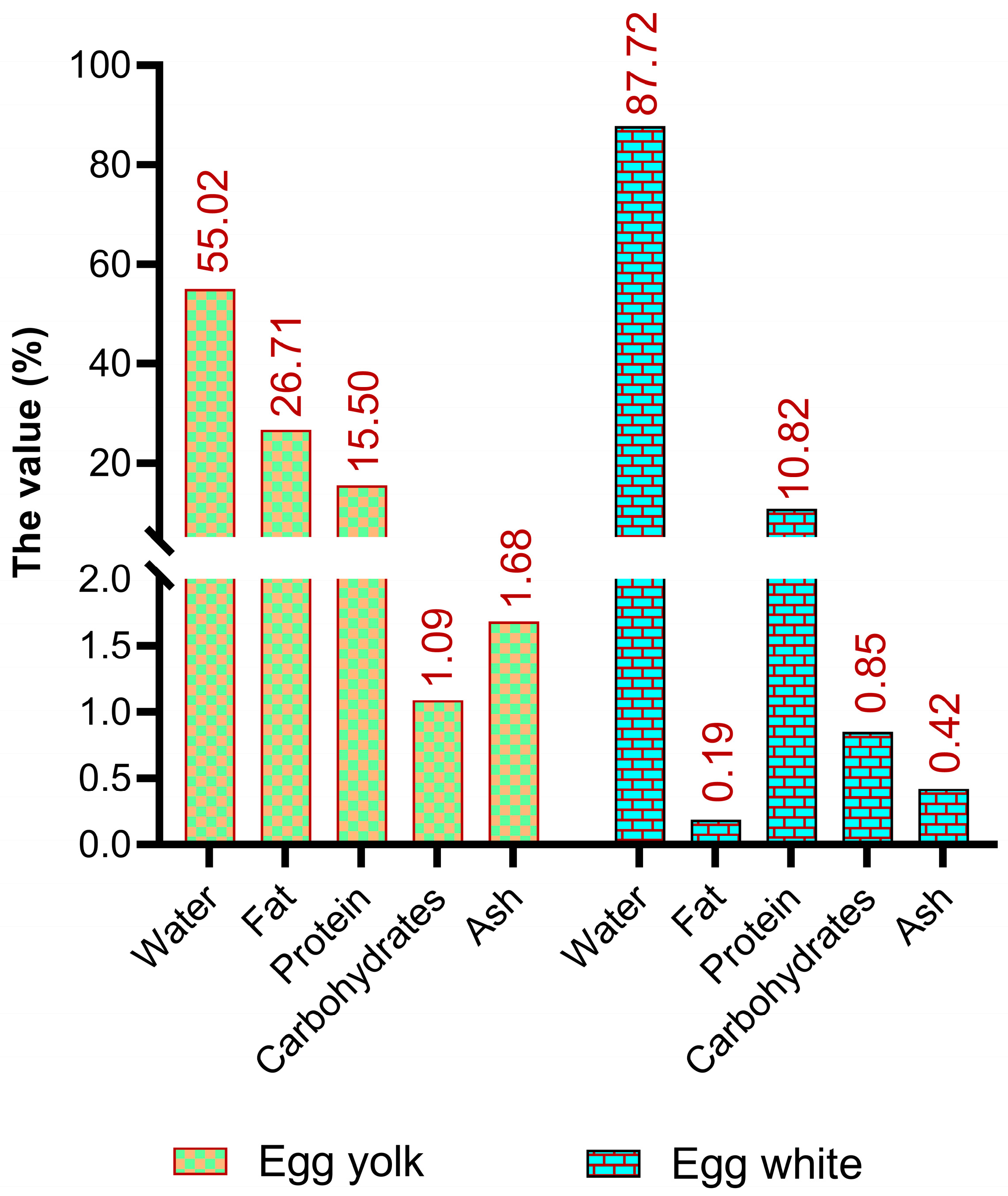
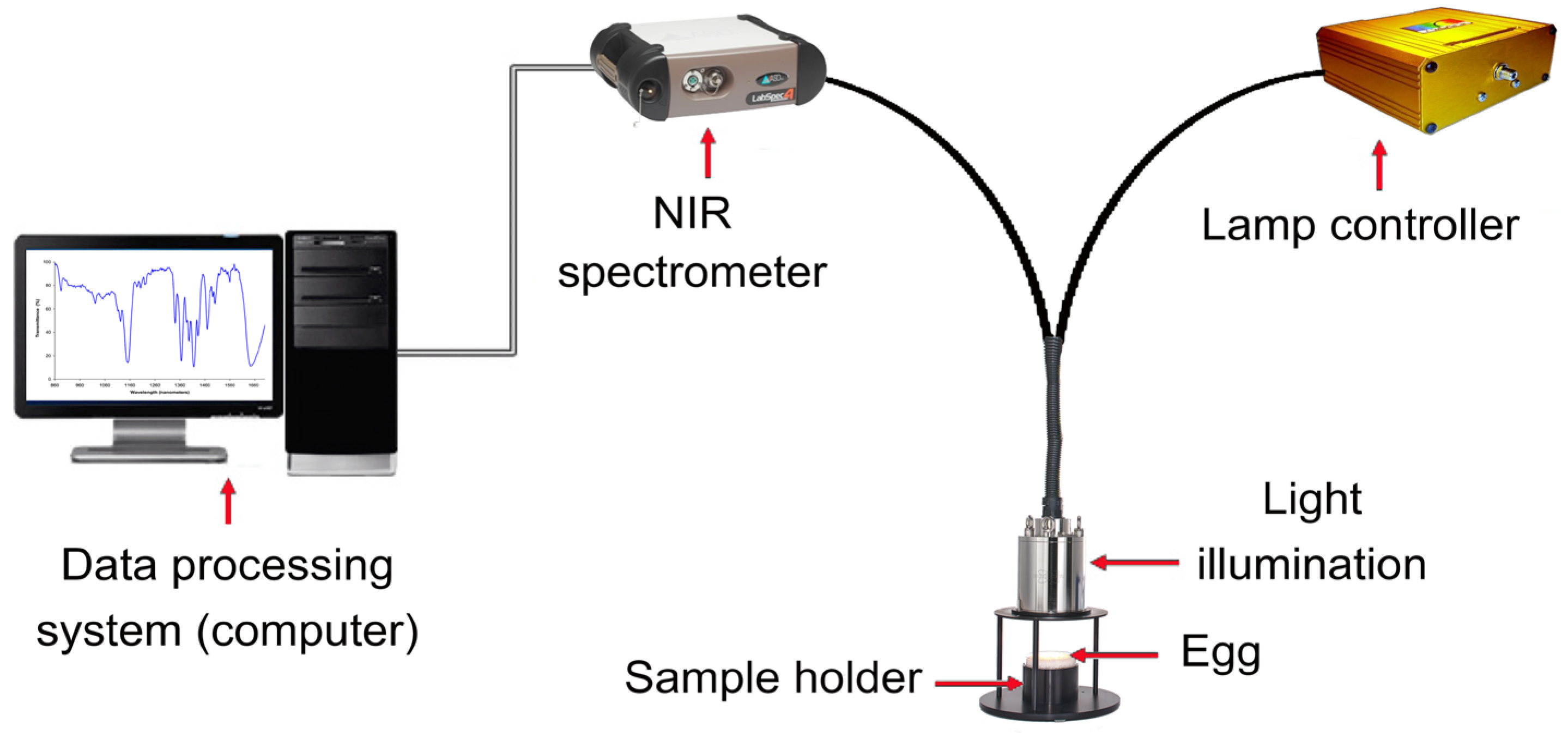
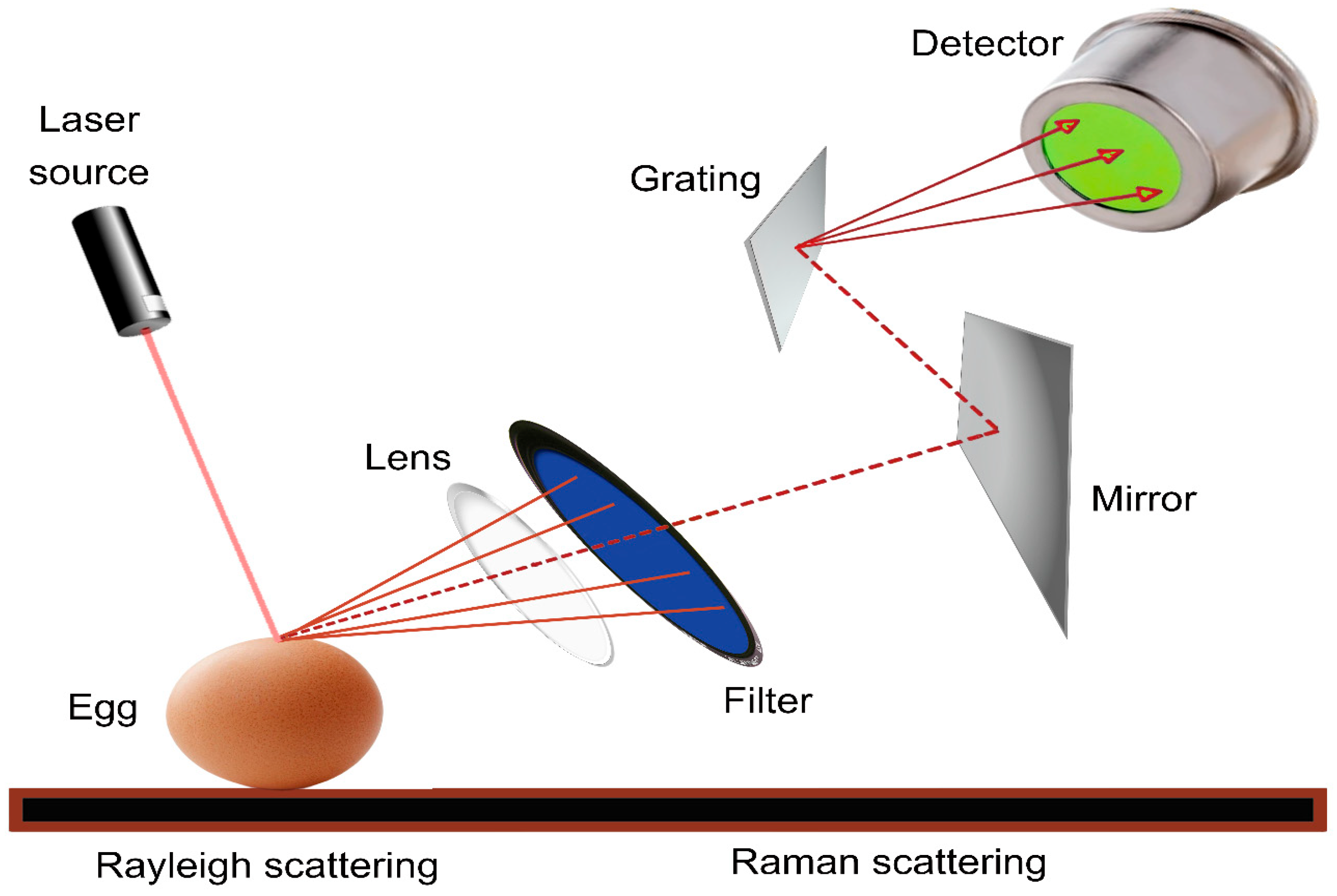

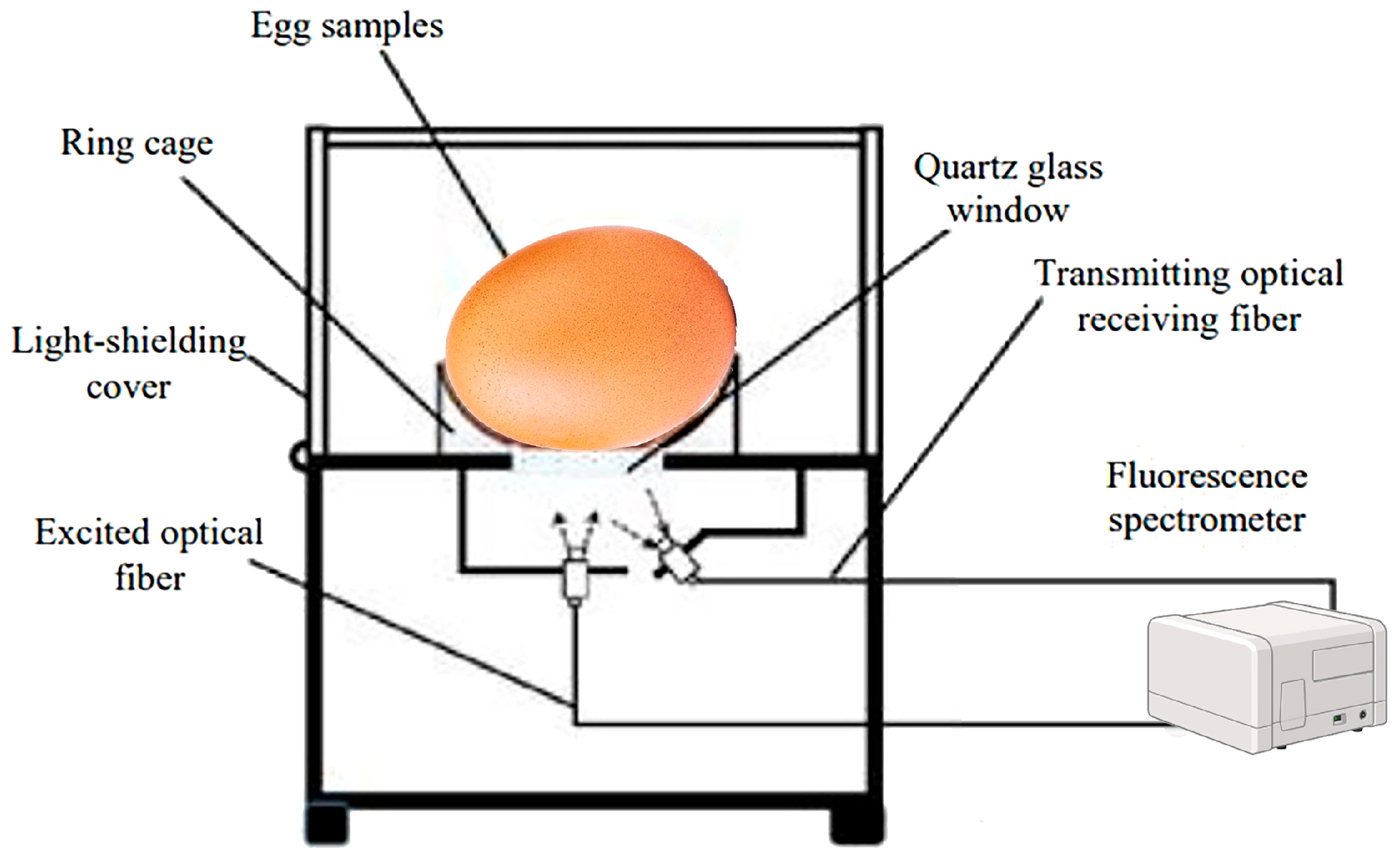
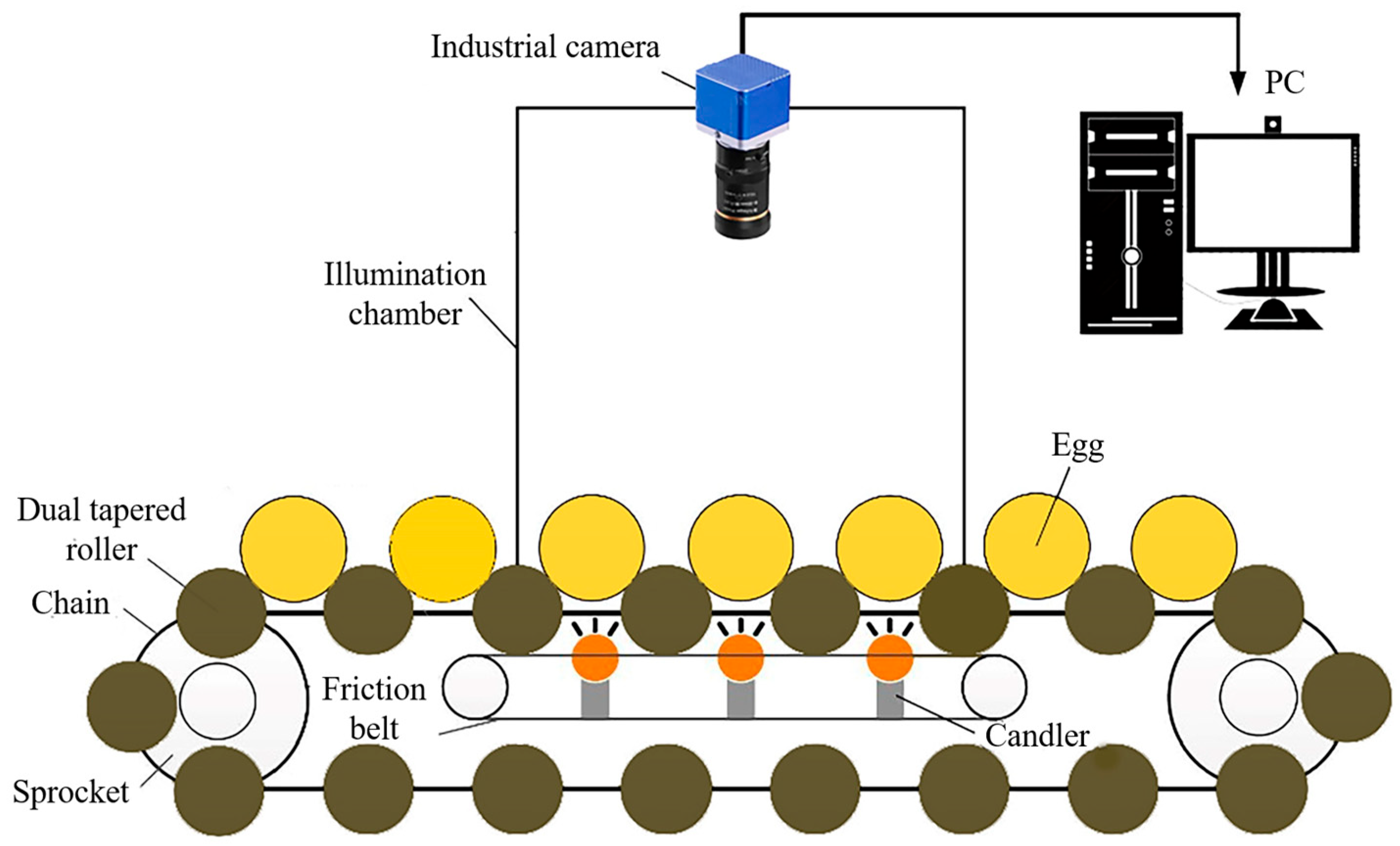
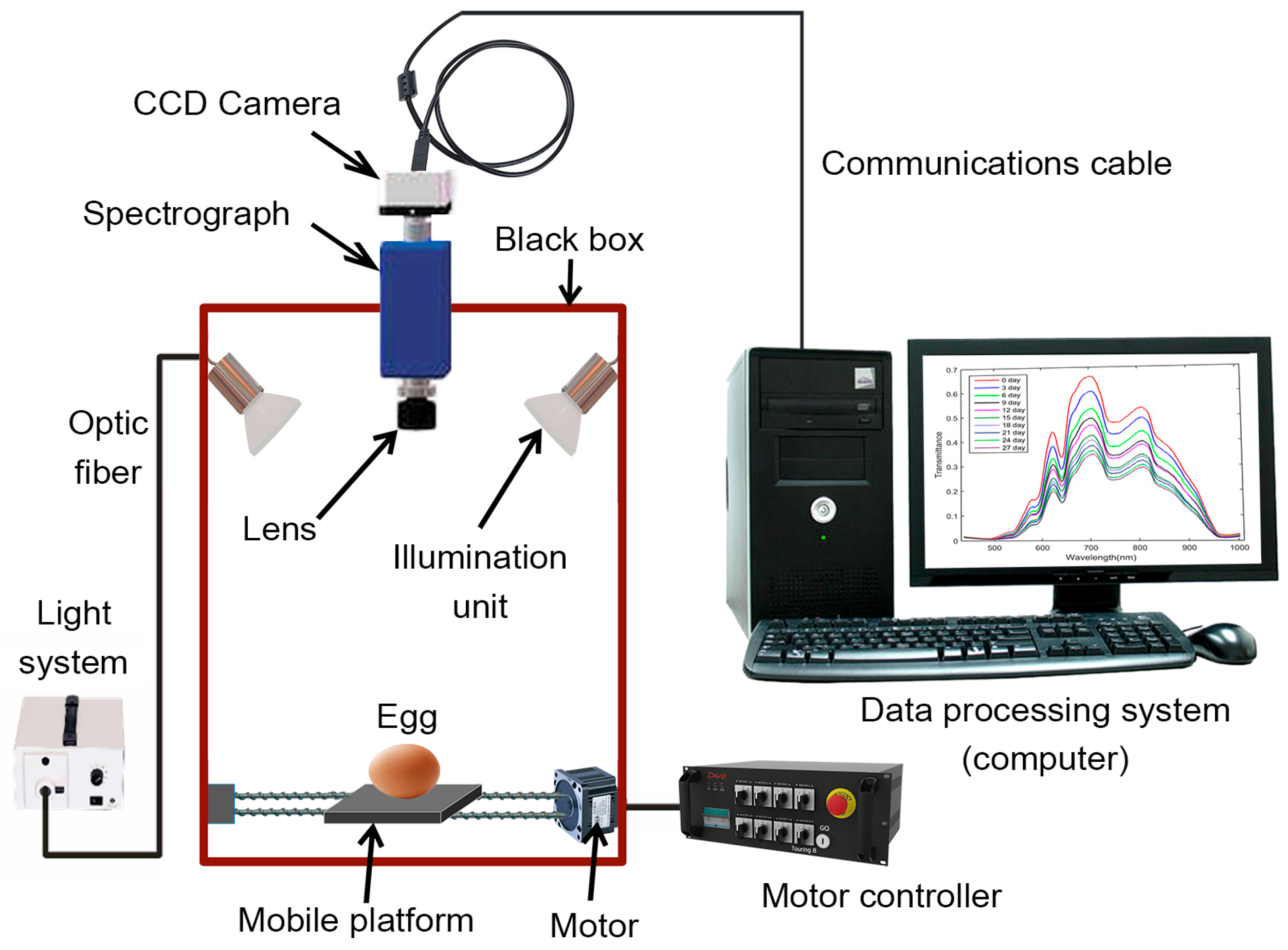
| Technique | Parameters | Model | Accuracy of the Best Models Obtained for Each Algorithm | Notice (Spectrum Range) | Ref. |
|---|---|---|---|---|---|
| Near-infrared (NIR) spectroscopy | Indexes of weight loss rate, yolk index, and Haugh unit | LDA | 91.40% | 550–985 nm | [70] |
| Integrated freshness index (IFI) | SVR | 81.60% | 500–900 nm | [71] | |
| Double yolk (DY) and single yolk (SY) | DA and SVM | 96% and 100% | 200–900 nm | [72] | |
| HU | SVMR and PLSR | 87.00% | 900–1700 nm | [73] | |
| Internal properties (Haugh unit, albumen height, yolk color, yolk weight, albumen weight, yolk coefficient (YC), and yolk height), and external quality (shell weight, strength, and thickness) | ANN | 94.00% | 400–1100 nm | [74] | |
| ACH, HU, albumen pH, TAH, and YC | ANN | 100% | [75] | ||
| Air chamber size, weight loss, and pH | PLS | 91% | [52] | ||
| Haugh units and pH of albumen | PLS | R2 = 0.82 and R2 = 0.86 | 200–1100 nm | [76] | |
| Raman spectroscopy | Haugh unit, albumen pH, and air chamber diameter | PLSR | 90.00% | 100–3000 nm | [19] |
| External and internal parameters of fake eggs | PLS-DA | 100% | 600–1800 nm | [77] | |
| Yolk freshness | PLS-DA | 80% | 950–3000 nm | [78] | |
| Dielectric spectroscopy | Haugh unit, yolk index, yolk/albumen, and yolk weight | ANN | R2 = 0.998, R2 =0.998, R2 = 0.998, and R2 = 0.994, respectively | 40 KHz–20 MHz | [79] |
| Air cell, thick albumen height, and yolk index | ANN | R2 = 0.918, R2 = 0.854, and R2 = 0.912, respectively | 3–20 GHz | [80] | |
| Fluorescence spectroscopy | Vitamin A and FMRP | PCA-FDA | 85.70% 63.90% | [81] | |
| Storage time | PCA-FDA | 94.40% | [82] | ||
| Computer vision | Length, breadth, and volume | Classification model | 99.88%, 98.26%, and 99.02%, respectively | [61] | |
| Haugh unit, yolk index, yolk/albumen ratio, and yolk weight | ANN | 99.8%, 99.8%, 99.8%, and 99.4%, respectively | [79] | ||
| Minimum, maximum, and effective radii, perimeter, and frontal area | Edge algorithm | 95% | [83] | ||
| Haugh unit using egg weight, long axis, and minor axis | MLR | 86.50% | [84] | ||
| Haugh unit and albumen pH | Levenberg–Marquardt | 93% and 87% | [13] | ||
| Dark spots on surface, soundness of eggshell | LFI (local fitting image) | 92.50% | [85] | ||
| Crack detection | New algorithm | 94% | [86] | ||
| Hyperspectral imaging | HU | PLSR | 91% | 900–1700 nm | [87] |
| HU | SVM, KNN, RF, NB, DAC, and LDA | 100%, 88.75%, 95%, and 96.25%, respectively | 400–2500 nm | [88] | |
| Freshness, bubble formation, or scattered yolk | SPA-SVM | R2 p = 0.87 | 350–1010 nm | [89] | |
| Electronic noses and tongues | Textures, smells, and tastes | KNN, LDA, and SVM | 96.70% | [90] | |
| Odor score, overall acceptability score, and HUs | FDA | R2 = 0.9441, R2 = 0.9511, R2 = 0.9725, and R2 = 0.9530, respectively | [91] | ||
| Haugh unit and yolk index | Multiple linear regression (MLR) and backpropagation neural network (BPNN) | 84% | [92] | ||
| Shelf life of eggs | PLSR | 95% | [93] |
| Techniques | Spectral Information | Spatial Information | Multi-Constituent Information | Online Applications | Simplicity | Data Dimension | Speed of Analysis | Cost |
|---|---|---|---|---|---|---|---|---|
| NIR spectroscopy | √ | √ | √ | √ | 1 D | Super rapid | Low | |
| Raman spectroscopy | √ | √ | √ | √ | 1 D | Rapid | Moderate | |
| Dielectric spectroscopy | √ | √ | √ | √ | 1 D | Rapid | Low | |
| Fluorescence spectroscopy | √ | √ | 1 D | Moderate | Moderate | |||
| Computer vision | √ | √ | √ | 2 D | Rapid | Low | ||
| Hyperspectral imaging | √ | √ | √ | 3 D | Moderate | High | ||
| Electronic noses | 1 D | Slow | Moderate | |||||
| Nuclear magnetic resonance | 2 D | Slow | High |
Disclaimer/Publisher’s Note: The statements, opinions and data contained in all publications are solely those of the individual author(s) and contributor(s) and not of MDPI and/or the editor(s). MDPI and/or the editor(s) disclaim responsibility for any injury to people or property resulting from any ideas, methods, instructions or products referred to in the content. |
© 2024 by the authors. Licensee MDPI, Basel, Switzerland. This article is an open access article distributed under the terms and conditions of the Creative Commons Attribution (CC BY) license (https://creativecommons.org/licenses/by/4.0/).
Share and Cite
Atwa, E.M.; Xu, S.; Rashwan, A.K.; Abdelshafy, A.M.; ElMasry, G.; Al-Rejaie, S.; Xu, H.; Lin, H.; Pan, J. Advances in Emerging Non-Destructive Technologies for Detecting Raw Egg Freshness: A Comprehensive Review. Foods 2024, 13, 3563. https://doi.org/10.3390/foods13223563
Atwa EM, Xu S, Rashwan AK, Abdelshafy AM, ElMasry G, Al-Rejaie S, Xu H, Lin H, Pan J. Advances in Emerging Non-Destructive Technologies for Detecting Raw Egg Freshness: A Comprehensive Review. Foods. 2024; 13(22):3563. https://doi.org/10.3390/foods13223563
Chicago/Turabian StyleAtwa, Elsayed M., Shaomin Xu, Ahmed K. Rashwan, Asem M. Abdelshafy, Gamal ElMasry, Salim Al-Rejaie, Haixiang Xu, Hongjian Lin, and Jinming Pan. 2024. "Advances in Emerging Non-Destructive Technologies for Detecting Raw Egg Freshness: A Comprehensive Review" Foods 13, no. 22: 3563. https://doi.org/10.3390/foods13223563
APA StyleAtwa, E. M., Xu, S., Rashwan, A. K., Abdelshafy, A. M., ElMasry, G., Al-Rejaie, S., Xu, H., Lin, H., & Pan, J. (2024). Advances in Emerging Non-Destructive Technologies for Detecting Raw Egg Freshness: A Comprehensive Review. Foods, 13(22), 3563. https://doi.org/10.3390/foods13223563










